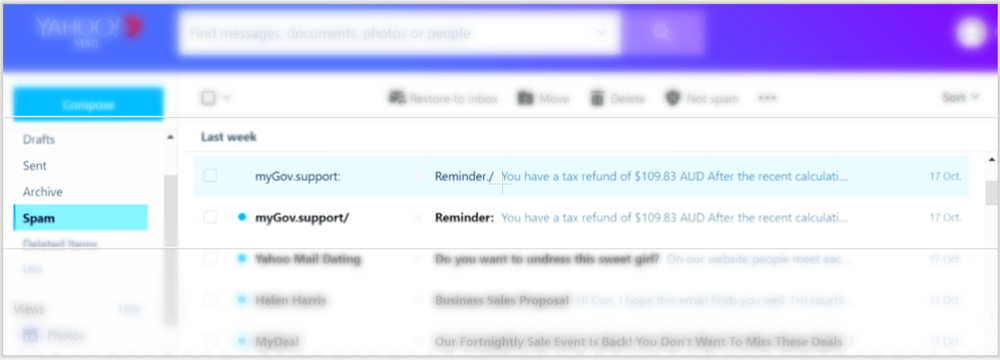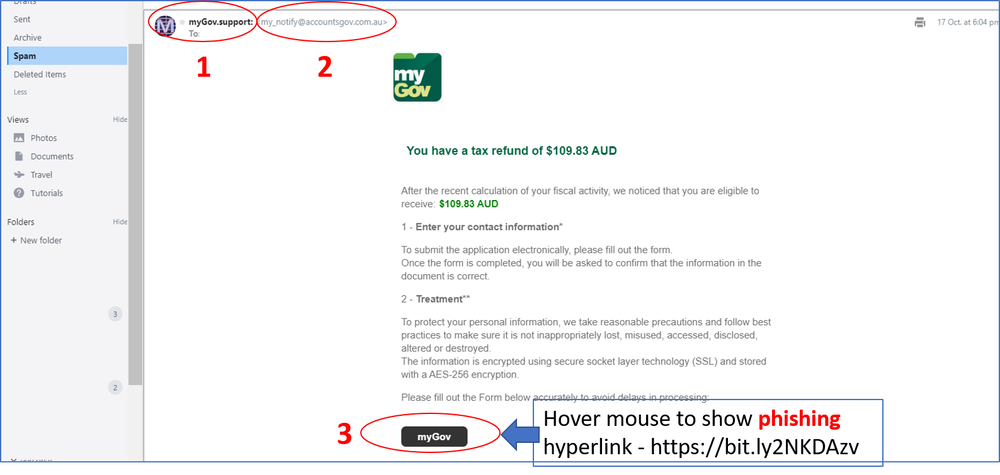Key statistics suggest that between 75 to 80% of all emails, on average, are spam or phishing emails – that’s easily about 190 billion emails per day.
Here are some great tips to help you identify fake emails, especially those phishing kind that want to steal your personal details, username and password to eventually steal money from your accounts.
Spam folder – there’s a reason why its called a spam folder. So if its in that folder, just leave it alone ! Technology works most of the time. If you believe that it was placed in that folder by mistake, call the brand that sent it and discuss it with the contact centre staff FIRST before doing anything further.

2. Read the FROM address carefully. The email sender address has 2 parts, so it’s important to understand what they do. From first glance, the email sender seems legitimate – “myGov.support” but is unfortunately fake. If the email is not in the SPAM folder, open up the email (note – if its in the spam folder, leave it there and speak to the brand’s contact centre for further advice.

- Part 1 – in this diagram, part 1 shows – myGov.support. This is a text field, called the display name, that is not controlled in any way, so you can write anything there within reason eg . Australian Gov, President Trump – and is used to get your attention and trust.
- Part 2 – in this diagram part 2 shows the second FROM address- “my_notify@accountsgov.com.au” and in this case it is fake. myGov emails will typically be sent from my.gov.au. If you’re keen to understand why I mentioned the second FROM address – here’s more reading material – The fundamental flaw in Email. Now this section can be controlled based on a new technology standard called DMARC. Without going too deep into the technology, the control part means that only myGov can send emails that have a FROM address of “no_reply@my.gov.au”. So it is an effective measure against phishing or fake emails. In fact, the Dept of Homeland Security USA issued a mandatory edict that ALL federal govt departments needed to have DMARC in place and in reject mode before the mid term elections in November 2018 following the outcry of election meddling. The website Phishing Scorecard keeps track of organisations – govt of all levels, utilities, banks etc and their “phishability” by hackers. Simply choose your country and see if your favourite brand is listed, otherwise write to support team to have it added.
3. Hover mouse to see phishing link. Don’t take for granted that the hyperlink is what it says its is. If you hover the mouse over the hyperlink – and remember it can be a picture or text, it will identify the actual link. So the myGov hyperlink picture has an actual url of https://bit ly2NKAzv that of course is a phishing link and has nothing to with the actual myGov website. NOTE – (1) the url link has been changed for your safety and (2) the actual link has been reported by our Security Operations Centre to the appropriate hosting vendor to have it removed.
Finally, I can’t stress enough the importance of having a subscription to anti virus software, and regularly update windows and other software updates on your pc, laptop and mobile device.
By Con Lokos
